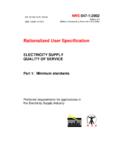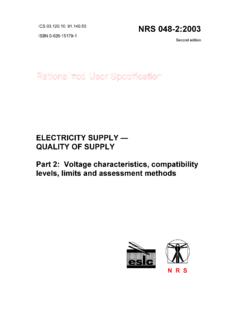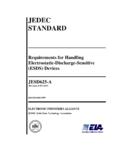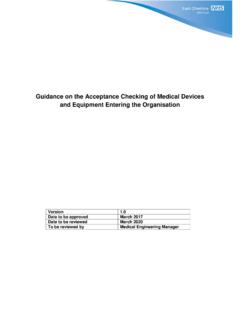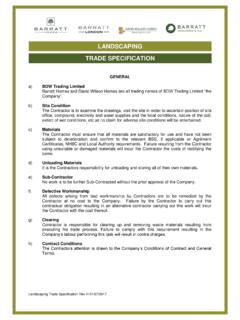Transcription of A guide to health and safety regulation in Great Britain HSE49
1 A guide to health and safety regulation in Great Britain Page 1 of 26 health and safety ExecutiveA guide to health and safety regulation in Great BritainContentsForeword 3 Introduction 4 The system 5 The health and safety Executive 5 Local authorities 6 Ministerial responsibilities 6 Consultation 7 Limits of HSE s responsibilities 7 Scotland 7 Wales 8 The legal framework 9 Duties imposed by the Act 9 regulations , codes of practice and guidance 9 Providing information and advice 10 Europe and the world 10 Competent authorities 11 Standards 11 Market surveillance 11 Enforcement 12 Enforcement policy 12 Powers of inspectors 12 Fee for Intervention 13A systems approach 13 Operational activities 14 Field Operations Directorate (FOD) 14 Hazardous Installations Directorate (HID) 14 Office for Nuclear regulation (ONR)
2 15 Training inspectors 15A guide to health and safety regulation in Great Britain Page 2 of 26 health and safety ExecutivePolicy 16 The policy process 16 Impact assessment 17 Evaluation and review 17 Sunsetting clause 18 Science and research 19 Control of risks at the workplace 20 Managing risk 20 Consulting employees 20 health and safety assistance 20 Permissioning regimes 21 Insurance and compensation 23 Diversity 24 Information for posted workers and non-English speakers 25 Posted workers 25 Language services 25 Further information 26A guide to health and safety regulation in Great Britain Page 3 of 26 health and safety ExecutiveThis guide outlines the occupational health and safety system in Great Britain (GB).
3 It responds to the many requests for information we receive from international visitors, enquirers and researchers, although many in Great Britain will also find it informative. The foundation of the current health and safety system in Great Britain was established by the health and safety at Work etc Act 1974. One simple but enduring principle that those who create risk are best placed to control that risk, whether employers, employees or manufacturers of articles or substances for use at work has led to Great Britain having one of the best combined health and safety records in the world.
4 Many other countries have used the GB model as a basis for their own framework. However, our model continues to evolve and it is therefore right that we describe the current system. We are also keen to listen to and learn from the experience of others to identify future improvements we might make. HSE s strategy for the whole health and safety system Be part of the solution was written following consultation with employers, employees and their representative groups from across the country, to help clarify respective roles and responsibilities, focus on real priorities and identify appropriate goals.
5 A number of recent reviews of the GB system have also confirmed our approach of supporting people who want to do the right thing, while holding to account those who choose to ignore their responsibilities, as an effective means for the regulator to play its part in reducing rates of work-related death, injury and ill health . I hope you find this updated guidance useful and HackittChair, health and safety ExecutiveForewordA guide to health and safety regulation in Great Britain Page 4 of 26 health and safety ExecutiveGreat Britain has a tradition of health and safety regulation going back over 150 years.
6 The present system came into being with the health and safety at Work etc Act (HSW Act) in 1974 ( ) with further significant modifications in 2008. The effect of this is to provide a unified institutional structure and legal framework for health and safety regulation . The health and safety Executive (HSE) enforces the law in many workplaces, ranging from health and safety in nuclear installations and mines, through to factories, farms, hospitals and schools, offshore gas and oil installations, the safety of the gas grid and the electricity distribution system, the movement of dangerous goods and substances, and many other aspects of the protection both of workers and the public.
7 In addition, over 380 local authorities are responsible for enforcement in a wide range of other activities, including the retail and finance sectors, and other parts of the services sector, particularly leisure. health and safety in nuclear installations is enforced by the Office for Nuclear regulation (ONR), which is an agency of standards of health and safety achieved in Great Britain are delivered by the flexible regulatory system introduced by the HSW Act, and are typified by the Management of health and safety at Work regulations 1999. They also reflect a long tradition of health and safety regulation going back to the 19th century.
8 Since the HSW Act was passed, HSE has been engaged in progressive reform of the law, seeking to replace detailed industry-specific legislation with a modern approach in which regulations , wherever possible, express goals and general principles, and detailed requirements are placed in codes and guidance. For more information about workplace health and safety development milestones in Great Britain see: is currently underway to further modernise and simplify the health and safety system, to ease the burden on business and encourage growth through ensuring the health and safety system enables employers to make sensible and proportionate decisions about managing genuine workplace risks.
9 The HSW Act clearly places responsibility on those who create the risk to manage it. This applies whether the risk maker is an employer, self-employed or a manufacturer or supplier of articles or substances for use at work. Whatever the corporate status, each risk maker has a range of duties that must be implemented to manage the risk. Workforce involvement and, in particular, the work of health and safety representatives, make an important contribution to raising standards of health and risks do not have to be removed but the law requires dutyholders to do everything reasonably practicable to protect people from harm.
10 An explanation of what reasonably practicable means is provided at Introduction A guide to health and safety regulation in Great Britain Page 5 of 26 health and safety ExecutiveThe health and safety system as a whole includes the many stakeholders who have a role in maintaining or improving health and safety standards. Those stakeholders include employers, self-employed, manufacturers, suppliers, workers, third-party organisations, HSE and local authorities. The health and safety Executive HSE consists of a governing Board of up to 12 non-executive directors and over 3200 staff (including those in its agencies the health and safety Laboratory (HSL) and ONR).










